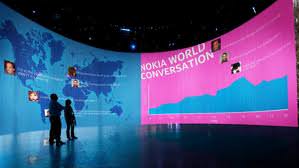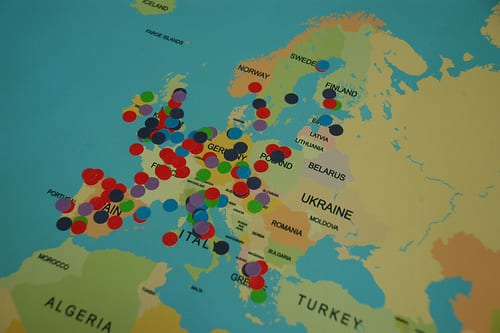Tools and tips to bridge and enhance online/offline live events
 This post by Lisa Harris, Nicole Beale and Graeme Earl reports on the findings of our Social Media in Live Events (SMiLE) action research project.
This post by Lisa Harris, Nicole Beale and Graeme Earl reports on the findings of our Social Media in Live Events (SMiLE) action research project.
The project is looking at real and virtual communities interacting around a ‘live’ conference.
Our focus is to show the learning points from this experience that can be applied improve the effectiveness of future events
Research methodology
Before, during and after the event we monitored a range of social media tools to track how the tools were used by real and virtual delegates. We expected the tools to be used for information recording and sharing, network building and profile raising.
During the event we carried out interviews with conference participants about their experiences and interactions via Twitter, Storify, Flickr, Vimeo, LinkedIn, Facebook, QR codes and Corkboard. We also collected delegate feedback after the event.
You can read more about the data we collected and our initial analysis of it on the LSE Impact Blog.
Student social media champions demonstrated event best practice in real time
The use of social media champions to demonstrate best practice in real time was very successful. For example, our student Digital Champions:
- Tweeted real questions raised in sessions and acted as rapporteurs - reading out online questions to the speaker.
- Shared links via Twitter and in paper abstracts - which were automatically saved into Delicious where additional commentary on the content could be added as notes straight away – this type of activity will simply not happen if left until later.
- Created Storifys focusing on specific themes or daily summaries - which were shared to allow people to read them at the event in the form of a daily email round up of activities from the previous day. After the event a single page was created on the conference website to showcase these summaries and collated contributions from blogposts, videos on Vimeo, links on Delicious and slides on Slideshare as they were published.
Key tools to enhance visualisations of social media activity
We were surprised by the scale of social media use during the conference; our archive of the #caasoton hashtag contains more than 13,000 tweets.
We are now exploring ways to add value to this archive through analysis and visualisation tools. We weren’t prepared for the urgent need for us to provide effective summarisation and visualisation in real-time, or at least soon after.
Even experienced social media users almost certainly missed out on the chance to participate in many relevant discussions because they were unaware of them in real time. Whilst we saw delegates pick up topics after the conference, the practical issues of moving on and the swift disappearance of tweets from searches mean opportunities for follow up are inevitably limited.
In terms of visualisations of social media activity, we have identified some core tools that could have been set-up for use prior to the conference. For example;
- Semantically enrich tweets via creating automatic links - the WP SIMILE timeline, or tools to semantically enrich tweets by creating automatic links to locations mentioned in tweets and between related themes.
- Produce more printed visualisations - as the conference progresses, just as we produced summary videos on each day.
- Link tweets with live streaming or broadcast video from the conference - rather than projecting what, at other conferences, have been distracting and, at times, inflammatory hashtag search twitterwalls alongside presentations, in the future we plan to use tools like SnappyTV’s vtweet feature - to link tweets with live streaming or broadcast video from the conference, and to edit tweets manually and semi-automatically into feeds tailored to particular sessions and topics. This way the remote user gets a social tv mashup, whilst the live audience can choose to follow a curated feed, and the presenter concentrates on talking and can respond to the twitter rapporteur at the end.
Actively encourage social media beginners to participate
Post-event feedback revealed delegates who were inexperienced social media users wanted more support during the event. So, we have incorporated a ‘help desk’ to get people started with twitter at subsequent events, to stop delegates feeling excluded.
It is also important to give a ‘voice’ to people who are not online, to prevent dominant conversations on twitter erroneously being claimed as representative of the views of all conference delegates.
Similarly, the dominant conversations on twitter could be skewed by diverse factors such as:
- The ease of summation of a given idea vs. the complexity of synthesising complex arguments
- The presentation style of research topics, perhaps by the use of ‘tweet sized bites’ of take home messages embedded in PowerPoints
During the event we handed out flyers to delegates with advice on structuring tweets to ensure tweeters could easily associate tweets with specific conference events and themes.
Learning points for effective integration of real and virtual event experiences
Here are some of the key learning points to help to create a bridge between real and virtual event experiences:
- During the course of the event we tried to support online events with offline events; for instance, by asking delegates to share memories of previous conferences using post-its on a long paper timeline, a gigapixel version of the timeline, and also a digital alternative of the same activity using Corkboard.
- Providing room booking facilities for people who ‘meet’ online while at the event to get together in a quiet space would also be useful. Some did arrange to meet up in advance of the conference by sharing their personalised event timetable.
- We could have made better use of ‘real’ notices rather than relying on twitter notifications. For example, people could be encouraged to leave contributions to the ‘theme of the day’ on a sticky board as well as online.
- We decided not to use smartphone accessible QR or similar badges with links to people’s profiles at the event because this requires profile information to be collected as part of the conference registration process.

- We encouraged conversations to build bridges between the social media and real world; for example, by creating maps showing where people had come from, and where tweets happened. The publication and tweeting of printed posters as pdfs before the conference also worked well - these were subsequently linked in real time to related conversations taking place on Twitter.
- It is important to be really clear about what content is being captured and what will be done with it after the event. One delegate noted she was aware video was being recorded, and had agreed to it, but hadn’t realised before the start that this could potentially capture her personal conversations. Capturing and sharing content was further complicated by our use of tools like Flickr to collect and annotate user-submitted photographs from previous events, dating back as far as the early 1990s.
Possible solutions to this situation include:
- Physically ‘badging’ people who do not want to be filmed, for the benefit of video editors
- ‘Red flagging’ tweets that their author does not want to be archived.
Create continuity between present and future events
We expect the materials we have created and archived will play a role in determining the structure and focus of next year’s event; as will ongoing members of the event organisation team.
For example;
- Follow-up persistent and emerging themes - emerging themes that generated significant debate could be allocated a specific session of their own and, by comparing content between the two events, it should be clear in which topic areas the debate has moved on and whether specific agreed actions have been delivered.
- Engage virtual event attendees - during the conference, there were various individuals who engaged with the event through social media who were not attending; indeed some were newly introduced to the community via those channels. This highlit the potential for the methods outlined above, not only for supporting the event’s community as it currently stands, but also for encouraging new membership, and broadening our reach beyond the confines of a single venue and time-frame.
About the authors
Lisa Harris is a senior lecturer at the University of Southampton focusing on digital marketing. She chairs the Digital Economy University Strategic Research Group with Graeme Earl. More details at: http://lisaharrismarketing.com
LinkedIn: http://www.linkedin.com/in/lisajaneharris
Twitter: @lisaharris
Nicole Beale is a PhD student at the Archaeological Computing Research Group, University of Southampton. She is researching into the cultural heritage sector can engage with the Web as social machine. She blogs at http://theculturalheritageweb.wordpress.com/
LinkedIn: http://uk.linkedin.com/in/nicolebeale
@nicoleebeale
Graeme Earl is a senior lecturer at the University of Southampton focusing on digital humanities research. He chairs the Digital Economy University Strategic Research Group with Lisa Harris. More details at: http://digitalhumanities.soton.ac.uk/people/graeme-earl/
LinkedIn://http://www.linkedin.com/in/graemeearl
Twitter: @graemeearl
With thanks to Buzz Radar for use of the conference image.








